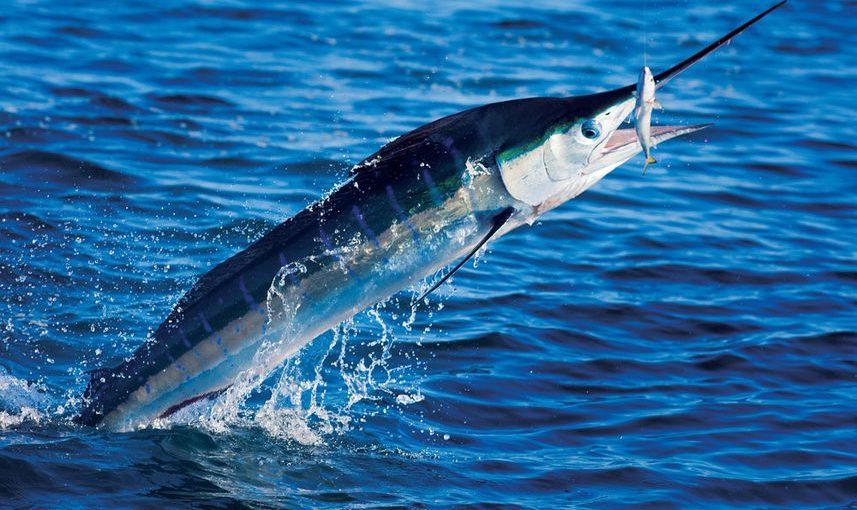How to catch striped marlin – Tips from the Pros
Tips and tricks from the top striped marlin captains in the world
Although these captains are not fishing striped marlin out of Costa Rica you may be interested in reading about new techniques as well as some you may recognize from around the globe – Also some great striped marlin facts below
Did you know striped marlin can top 300 or even 400 pounds? Or how to tell the difference between a striped marlin and a blue marlin? This guide will tell you everything you need to know about striped marlin.
Many anglers consider the striped marlin to be the perfect billfish. It’s certainly among the most beautiful, with its bluish-purple stripes vividly blazing along its flanks. Striped marlin (nicknamed stripies) readily bite a wide variety of baits, and because of their habit of tailing on the surface, they also offer anglers the unique opportunity to sight-cast to individual fish. They’re among the most acrobatic of any marlin, with the speed and strength to catapult themselves in explosive aerial displays. And while they may not reach the grander status of their larger blue- and black-marlin cousins, striped marlin have been known to top 300 to 400 pounds in certain parts of the world.
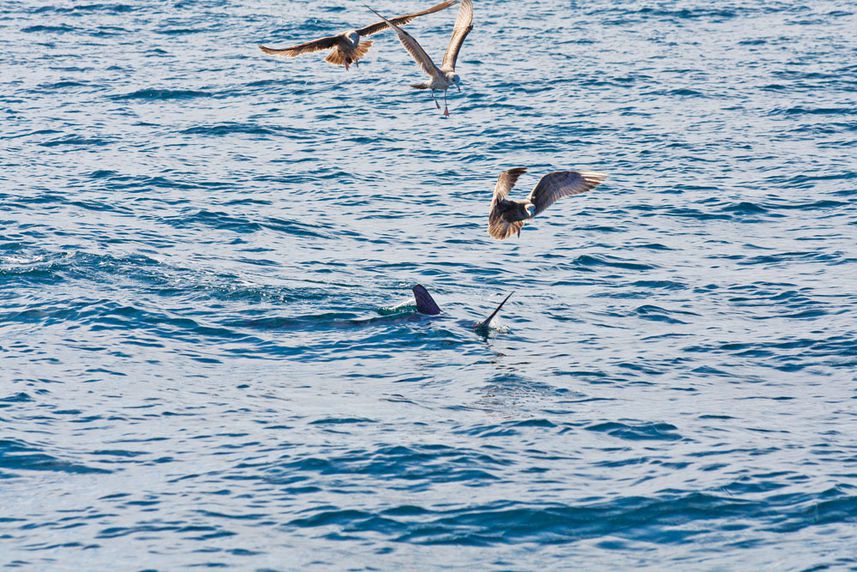
striped marlin in water
Striped marlin are found in the Pacific Ocean and can live in much cooler water than blue, white or black marlin. In this photo, birds and striped marlin attack the same bait ball.Scott Kerrigan / Aquapaparazzi.com Striped Marlin are a Pacific Species
Striped marlin are a Pacific species; however, they still cover the most extensive range of any billfish species. Their habitat stretches from the west coast of the United States, Mexico and South America across the wide expanse of the Pacific and throughout the Indian Ocean all the way to Africa and New Zealand.
Somewhere along the evolutionary trail millions of years ago, billfish species developed differing traits and later were divided into separate groups. Sailfish belong to one genus (Istiophorus), Pacific and Atlantic blue marlin to another (Makaira) and black marlin to a third (Istiompax). Striped marlin, along with white marlin and the three species of spearfish, make up a fourth genus (Kajikia). Interestingly, striped marlin can also tolerate much cooler water temperatures than blue, white or black marlin, which means they can push deeper into the corners of the Pacific than other billfish species. The largest striped marlin inhabit the cool waters off New Zealand. That nation owns the current all-tackle world record, a 494-pounder caught back in 1986 by angler Bill Boniface. New Zealand is still the world’s hottest spot for those wanting to catch the very largest striped marlin. The size of the striped marlin in new Zealand are second to none.
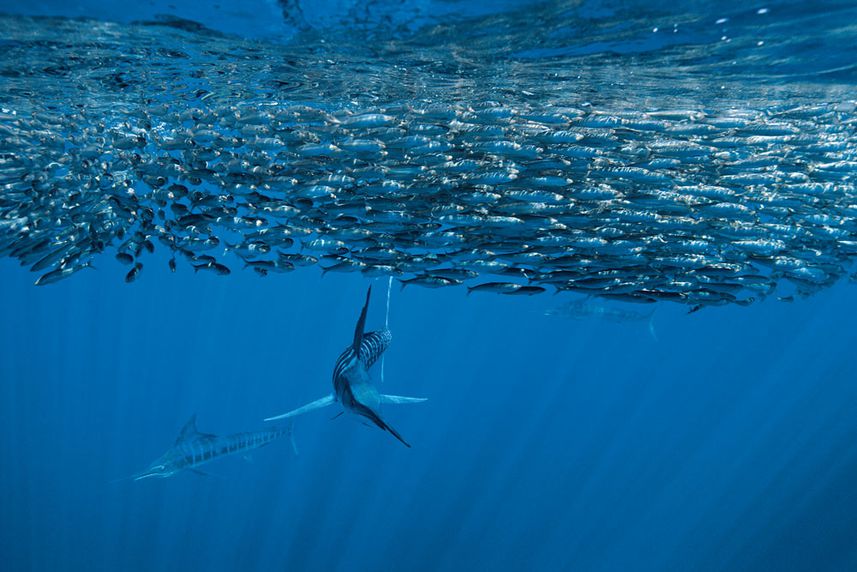
Unlike most marlin, which are primarily solitary creatures for most of their lives, striped marlin will school up like sailfish and feed cooperatively. Photo by Brandon Cole
Rather than focusing on sheer size, striped-marlin fishing is more of a numbers game — and they can be some pretty incredible numbers. The presence of bait definitely encourages schooling behavior, with the marlin acting more like sailfish, herding sardines or other small baitfish into tight balls before taking turns slashing through the schools.
One region where this phenomenon occurs fairly often is in southern Mexico, specifically the Baja Peninsula region from Magdalena Bay to Cabo San Lucas and up inside the Sea of Cortez to East Cape. Just how productive can this fishery be? In 2007, a group that was fishing out of Cabo on Reelaxe released 330 striped marlin in just two days, letting go an incredible 190 striped marlin among five anglers in a single day, on Dec. 8, 2007. While these types of numbers are certainly unusual, it’s not uncommon for anglers fishing bait balls to experience double-digit release days.
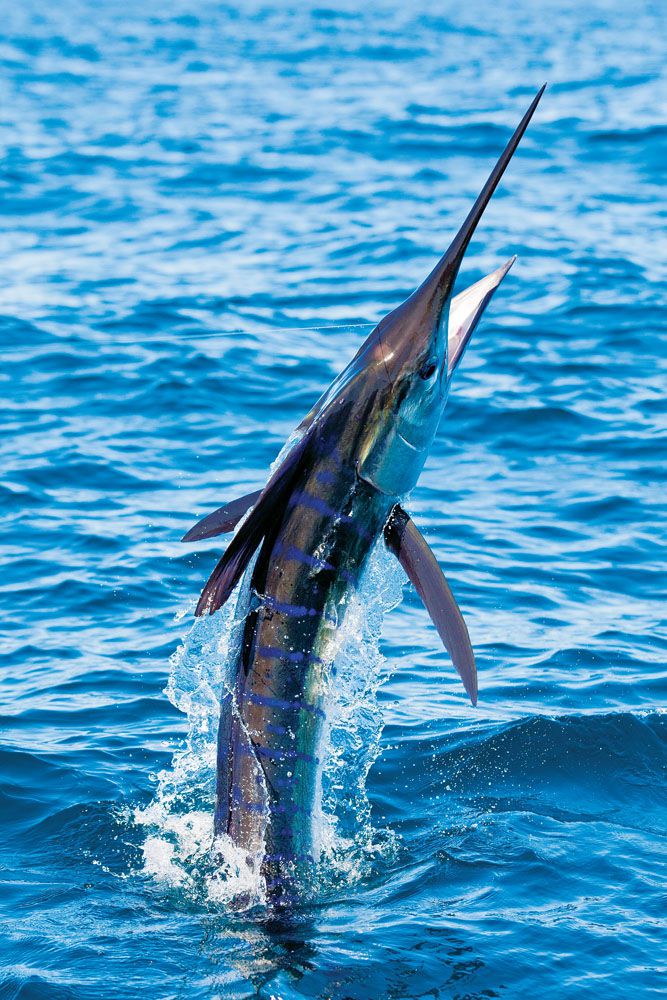
Cabo San Lucas, Mexico, is home to the one of the best striped marlin fisheries in the world.Scott Kerrigan / Aquapaparazzi.com
Cabo San Lucas Striped Marlin Fishing
Cabo San Lucas, Mexico, is regarded as the world’s epicenter for striped marlin for many reasons. It’s a well-known destination that’s easily accessible from just about anywhere, and the harbor is home to hundreds of charter boats. It’s also a matter of geography: Cabo is perched at the very tip of Mexico’s Baja Peninsula, where the Sea of Cortez meets the Pacific Ocean.
In short, it’s striped marlin central. One charter operation that takes full advantage of this is the world-famous Picante fleet. Founded by Phil Gentile in the early 1990s, Picante features the largest fleet of Cabo Yachts in charter service anywhere in the world. The captains and crews in this fleet fish hard, often more than 250 days a year, and are widely regarded as among the best in the world when it comes to finding and catching striped marlin.
“We have striped marlin year-round here in Cabo. But February through August are the prime months,” Tony Craig, Gentile’s brother-in-law, says. “We use four primary techniques to locate and catch these fish: slow-trolling live bait or dead baits, trolling with lures and spreader bars at a faster clip, soaking live baits at 50 to 100 feet, and looking for marlin on the surface.”
To a great extent, the Cabo fishery revolves around the use of live bait. Craig says their boats typically spool up their 30-pound-class reels with 50-pound-mono and 100-pound-test leaders for casting live baits to fish on the surface. “Our top live baits are mackerel and caballito (Mexico’s goggle-eye),” he says. “But other species will work. We use circle hooks ranging in size from 7/0 to 9/0, depending on the size of the bait.”
When it comes to lures, the Picante captains typically reach for smaller skirted trolling lures in the 6- to 10-inch range in either Mean Joe Green (green skirt over black) or Petrolero (a combination of orange, brown and black skirts, sometimes striped with red or silver). If a fish is raised to a lure but is not immediately hooked, the crew fires out a frisky live bait that’s already been bridled to the circle hook. It’s a deadly technique that would work on any billfish, anywhere in the world.
Striped Marlin Fishing Magdalena Bay, Mexico
In this part of the world, Capt. Steve Lassley represents the go-to guy when it comes to striped-marlin expertise. He’s won every striped-marlin money tournament in California and has a long history of other achievements, including multiple wins in the Bisbee’s Black and Blue. He picks Magdalena Bay, some 200 miles up the Pacific coast from Cabo, as his top striped-marlin destination.
“From October through early December, the fishing at Mag Bay can be absolutely incredible,” Lassley says. He has spent two months in this region almost every year from 1984 through 2006. “While I consider the whole region from Turtle Bay to the Finger as part of ‘Mag Bay,’ we always just stopped where we found the fish,” he says. “It always seems like the main body of marlin sets up camp in one area or on one bank, and that’s where they’ll stay for the season. When you locate that volume of fish, it can be obscene — I can’t tell you the number of times that our anglers were worn out by 9 a.m.”
Because striped marlin often cruise on the surface, sight-fishing for them is one of the most popular and productive tactics, especially in Southern California and down through Baja to Cabo San Lucas. Spend the extra money and buy a good set of gyrostabilized binoculars, such as the Fraser Optics’ Mariner Series.Staff
Working south as the season progresses, Lassley picks Cabo as his next destination, from April through the end of May (although in some years November through January can be very good as well); then he goes up to Loreto in the Gulf of California from May through August.
Lassley’s preferred fish-finding tactics rely heavily on the use of gyrostabilized binoculars, so his typical spread reflects the mentality of seeing the fish first and then catching it. “We’ll normally pull two lures or ballyhoo and two [squid teaser] chains,” he says. “That way it’s easy to clear everything when you start seeing fish on the surface.” If the fish aren’t on the surface, the technique switches to electronic fishing with fathometers and steerable sonar to scan for bait schools far below the surface. The dredges, spreader bars, daisy chains and ballyhoo come out once Lassley locates the bait schools.
Mag Bay also holds a special place in Bill Boyce’s heart. From fisheries biologist to globe-trotting television-show host, he’s had a chance to wet a line in some of the world’s most incredible fisheries, but he considers it to be one of the world’s top destinations for encountering striped marlin, and in pretty incredible numbers.
“It doesn’t happen every year,” he cautions. “But when the bait shows up and the planets align, the striped-marlin fishing there can be unreal.” Boyce recommends a prospecting spread of two lures. The Zuker’s 3.5-inch in black and purple or Petrolero and a Sevenstrand Tuna Clone in black over green or green mackerel see a lot of time in his spread. He also likes the Mold Craft Wide Range in a purple/black/silver mackerel pattern. His live bait of choice would be a frisky Pacific mackerel pinned or bridled to a 9/0 Eagle Claw circle hook.
“If we’re looking for fish, then I like to pull the lures in the outriggers through Roller Troller clips to keep them running in clean water,” he says. “But if you’re seeing some fish or hearing action on the radio, then I’ll move them down to the flat-line positions. I do this for two reasons: It’s easier to clear them in a hurry when a fish pops up, and you can also pitch a live bait right over the spread if a fish shows up on the surface beside the boat,” he says. “You have to be ready to get that bait out as quickly as possible.”
striped marlin at surface of water
Striped marlin on the surface fall into three general categories: sleepers, tailers and feeders. That is until you hook one, then they become jumpers! Dave Ferrell
Striped Marlin Facts
Then there’s the vocabulary of striped marlin on the surface. Because they spend so much time up on top, sight-casting with live bait is not only a preferred tactic but an adrenaline-filled rush too. “It’s unlike any other marlin fishery — you’re literally eyeball to eyeball with the fish,” Boyce says. He says that striped marlin on the surface fall into three general categories: sleepers, tailers and feeders. “A sleeper is laying almost motionless on the surface, typically first thing in the morning,” he says. “Usually you have to be very close with your live bait to get them interested. Come up from behind or from the side and cast well in front of it,” he says. Once the afternoon wind picks up, striped marlin will start riding the swells down-sea, a behavior called tailing. “The best way to fish tailers is to crisscross the down-sea pattern and look down the faces and in the troughs for marlin surfing the swells,” he says. The most active of the three types, a feeder is a striped marlin that’s chasing baitfish on the surface, often with a frigate bird or two just overhead. For this one, just put the bait in the ballpark and hang on.
Galapagos Striped Marlin Fishing
There’s another striped-marlin honey hole that’s come on strong in the last few seasons: the Galapagos Islands. Situated some 600 miles off the coast of Ecuador, the Galapagos gives anglers not just a taste of fishing in one of the world’s most untouched destinations but also an opportunity to tour some equally diverse ecosystems back on dry land. In 2001, Braden Escobar formed Ecuagringo Adventures and began chartering for striped marlin in the Galapagos Islands.
“Our best time is from December to May, when the seas are the calmest,” he reports. “But we have striped marlin here every month of the year. Most days we can expect to see five to 30 striped marlin a day, but we do have our 50-plus fish days too.” He rigs mostly 8/0 and 9/0 circle hooks on their big 10- to 14-inch native ballyhoo from Salinas but says that lures are very popular as well. “We use a mix of TLD 25 and TLD 50 tackle, since we always have a shot at a blue or black marlin. And we have bigeye tuna over 300 pounds here too.”
The coast of Ecuador and Peru has its share of big striped marlin as well. It’s not unusual to see 10 or 15 fish a day when the conditions are right, and these are no slouches either; there are plenty of 200-pounders swimming in these waters.
Striped marlin are also actively targeted in a number of other top fishing destinations around the world, including Southern California, Costa Rica, Hawaii, Australia and elsewhere. No matter where they’re found, they remain one of the world’s most popular billfish species.
striped marlin swimming in water
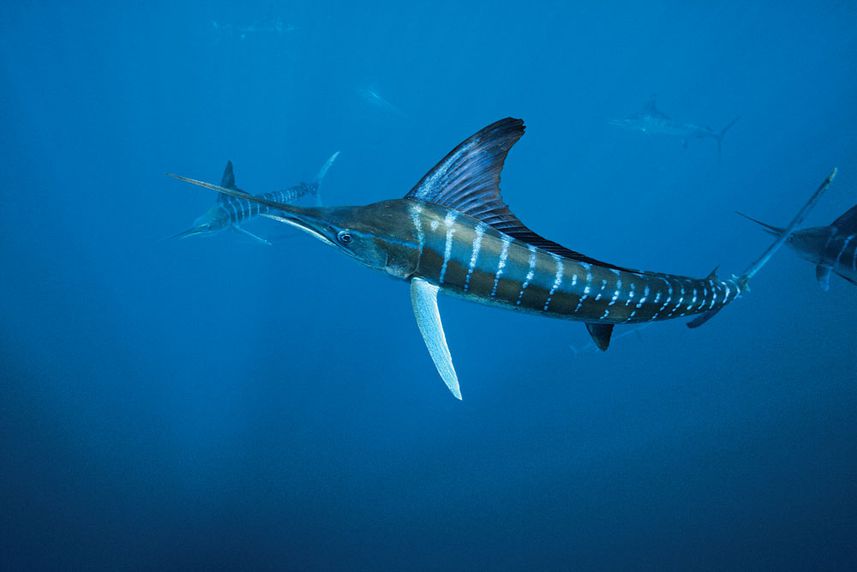
The most definitive way to tell the difference between a striped marlin and a blue marlin is the dorsal fin: A striped marlin’s is much taller in comparison.Brandon Cole
The Difference Between a Blue Marlin and Striped Marlin
A small marlin explodes from the surface of the Pacific, tail-wagging and pecs out. But is it a small blue or a striped marlin? Here are three things to look for:
The dorsal fin: This is the most definitive way to tell the difference. A blue marlin’s dorsal fin is no taller than roughly half of the depth of its body, whereas a striped marlin’s dorsal fin is much taller, nearly as tall as the depth of the body. So, if your marlin has a very tall dorsal, it’s a striped marlin.
Body shape: It’s a characteristic that takes a little more practice to discern, but a blue marlin is rounder in shape, whereas a striped marlin has a more flattened shape. In other words, if you sawed a blue marlin in half, the cross section would be nearly round, whereas the striped marlin would be egg-shaped.
Shape of the lower jaw: The lower jaw of a striped marlin is thin, narrow and pointed; in blues it’s shorter and fatter.
Don’t rely on the fish’s coloration or whether or not it has stripes. Blues can display very vivid stripes, and striped marlin don’t always have their flanks lit up.
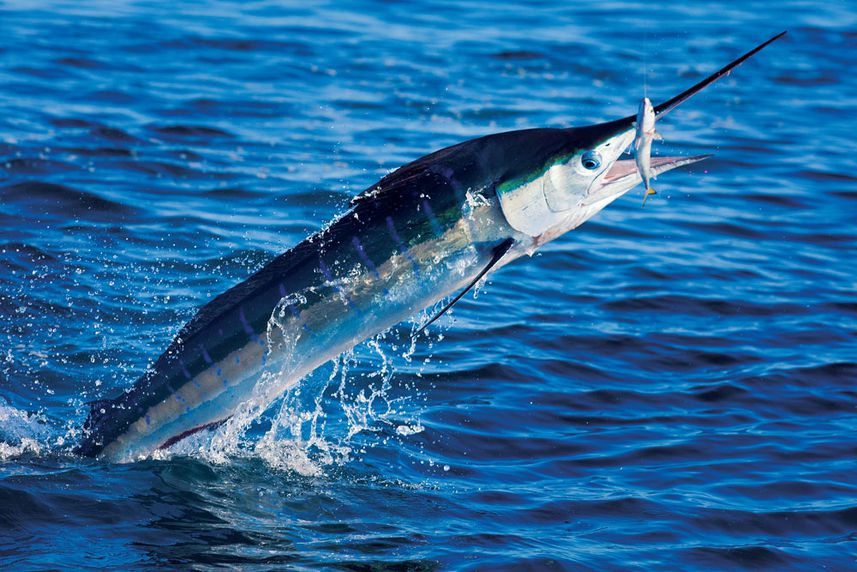
Striped marlin readily bite a wide variety of baits, and because of their habit of tailing on the surface, they also offer anglers the unique opportunity to sight-cast to individual fish.Scott Kerrigan / Aquapaparazzi.com
Gyrostabilized Binoculars for Striped Marlin
Because striped marlin often cruise on the surface, sight-fishing for them is one of the most popular and productive tactics, especially in Southern California and down through Baja to Cabo San Lucas. Capt. Steve Lassley has spent a good part of his life peering through gyrostabilized binoculars in search of striped marlin, so here are a few tips on getting more out of your time on the gyros.
First, use the glare to your advantage: “Stare at the glare. The tips of the fish’s tail will stand out black against the glowing background. Your eyes will feel like they’re bleeding at the end of the day, but you’ll see a lot more fish,” Lassley says.
If it’s windy, head down-sea or quarter down-sea and look down the troughs of the waves at the 3 and 9 o’clock positions. “You’re more likely to see the wide part of the fish’s tail as it heads down-sea, rather than trying to pick up the knife edge of the tail from another angle,” he says.
Once you spot a fish in the gyros, don’t take your eyes off it until another spotter or the captain picks it up and says they have it “eyeballed,” meaning with the naked eye, out of the glasses.
When trying to spot a fish someone else has in the gyros, take off your polarized sunglasses or drop them down on your nose and look over the top. “You need the contrast that the polarization eliminates,” Lassley says. “Your glasses are great for spotting fish underwater but terrible for spotting fins above the surface. Trust me on this one.”
Spend the extra money and buy a good set of gyrostabilized binoculars, such as the Fraser Optics’ Mariner Series. “The Fraser Volpe 12x are my glasses of choice, but Fujinon makes some good ones as well,” he says.
Lastly, Capt. Lassley reminds everyone that the more you put into your efforts, the more you will gain from them. Grind it out and you’ll be rewarded.
You may also like
How to catch billfish on the fly
Roosterfish – A fish to crow about
Tips and Tricks – Hooking a marlin or sailfish after a miss
Costa Rica Sport Fishing Destinations: Golfito
Do I have a blue or black marlin on my line?
Post Covid fishing in Costa Rica
How to identify billfish species
Subscribe to our mailing list
[yikes-mailchimp form=”1″]

